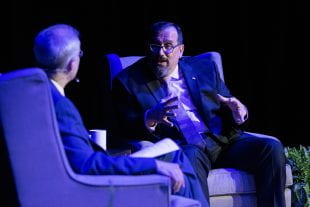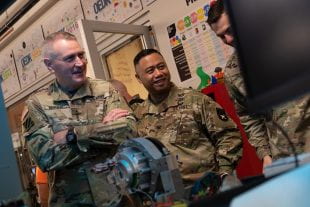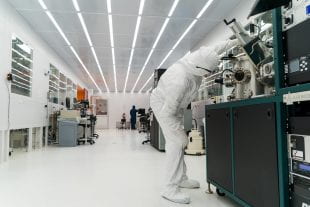Diamond electronics, self-aware networks could benefit millions worldwide
Rice University and the Army have established a five-year, $30 million cooperative agreement for research to enable advanced materials and next-generation networks. The effort is aimed at unprecedented intelligence, surveillance and reconnaissance specifically focused on next-generation wireless networks and radio frequency (RF) electronics.

Phil Perconti (right), director of the Army Combat Capabilities Development Command Army Research Laboratory (ARL), and Yousif Shamoo, Rice vice president of research, describe a new ARL-Rice cooperative agreement for Rice faculty Oct. 31. (Photo by Jeff Fitlow/Rice University)
“This is all about modernization for the United States Army,” said Phil Perconti, director of the Army Combat Capabilities Development Command Army Research Laboratory (ARL) in Adelphi, Maryland. “Our relationship with Rice is setting the stage for bringing new, disruptive research technologies — transformative research — to the Army so that it can increase its capabilities in the future.”
The Rice-ARL partnership stemmed from a visit to Rice earlier this year by Gen. John Murray of U.S. Army Futures Command, a new four-star command the Army established in 2018 to oversee the Army’s modernization priorities.
“ARL and Rice will match the right people and capabilities to meet specific challenges, and the cooperative agreement is structured to allow the Army to partner widely across our campus,” said Yousif Shamoo, Rice’s vice president of research and lead on the ARL partnership. “One exciting aspect of this partnership is the broader societal benefits. The technologies we’re starting with are needed for Army modernization and they could also benefit millions of Americans in communities that still lack high-speed internet.”

Gen. John Murray (left), commander of U.S. Army Futures Command, speaking with students at the Oshman Engineering Design Kitchen during an April 2019 visit to Rice University. (Photo by Jeff Fitlow/Rice University)
Thirty years ago, the Department of Defense led the development of gallium nitride semiconductors, a wide-bandgap alternative to silicon that is the mainstay of today’s high-performance radio frequency (RF) electronics and power electronics. The ARL-Rice diamond materials team is working toward an ultrawide-bandgap successor to gallium nitride. RF hardware improvements could benefit the autonomous networks team, which is looking to transform the labor-intensive and time-consuming process of setting up and managing wireless networks.
The diamond team is co-led by Pulickel Ajayan, chair of Rice’s Department of Materials Science and NanoEngineering (MSNE), and Tony Ivanov, branch chief of ARL’s Electronics and RF Division, and also includes MSNE faculty member Robert Vajtai. It plans to build a one-of-a-kind facility at Rice for growing ultrapure diamond films and heterostructures of diamond and other materials that can be used in RF electronic prototypes.

Researchers from Rice and the Army Research Laboratory will work in Rice’s clean room and other facilities to develop ultrawide-bandgap diamond semiconductors for use in high-performance radio frequency (RF) electronics and power electronics. (Photo by Brandon Martin/Rice University)
The networking team aims to create distributed, self-aware networks that can sense attacks and protect themselves by adaption or stealth. The team is co-led by Rice’s Ashutosh Sabharwal, chair of Rice’s Department of Electrical and Computer Engineering (ECE), and Ananthram Swami ’80, senior research scientist in ARL’s Network Science Division, and also includes Rice ECE faculty members Edward Knightly and Santiago Segarra.
Heidi Maupin, the regional director of the ARL South in Austin, and the lead ARL contact for the Rice partnership, said the technology will benefit both the Army and civilians.
“We want to deliver the capability of quickly deploying secure, robust Army communications networks wherever and whenever they’re needed,” Maupin said. “The technology needed for that will benefit the world by transforming the economics of rural broadband, reducing response times to natural disasters, opening new opportunities for online education and more.”
Elevating research achievement and reputation and extending Rice’s reach and impact are goals of Rice’s Vision for the Second Century, Second Decade.

